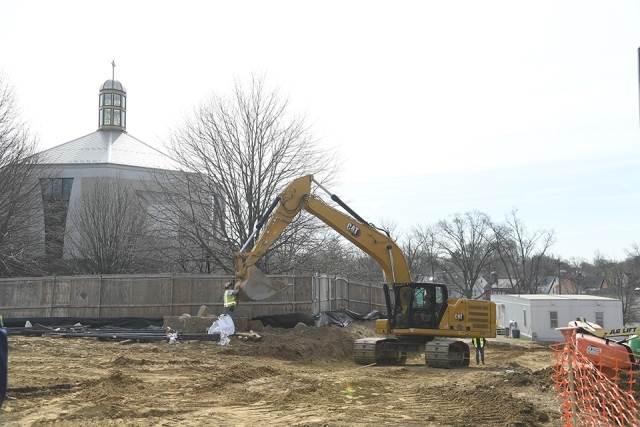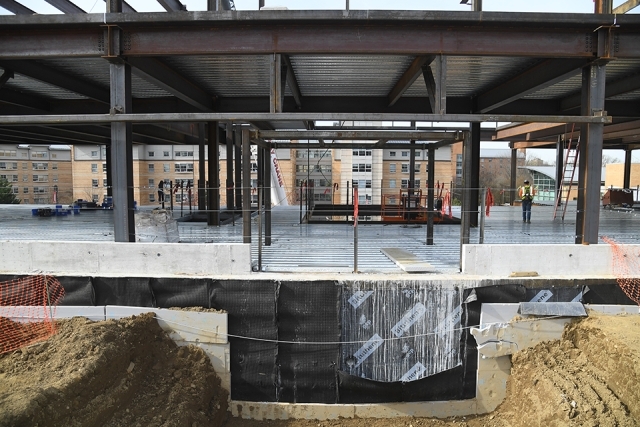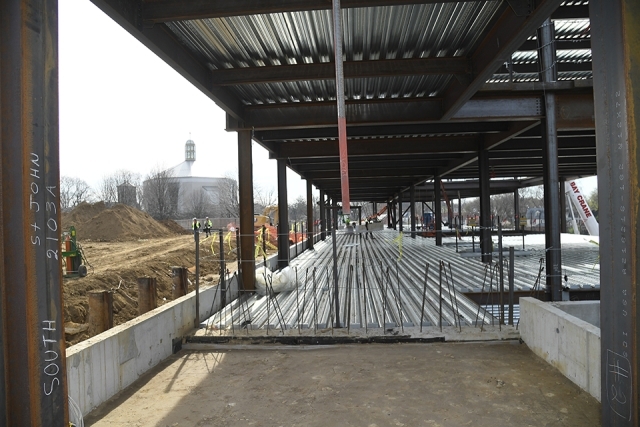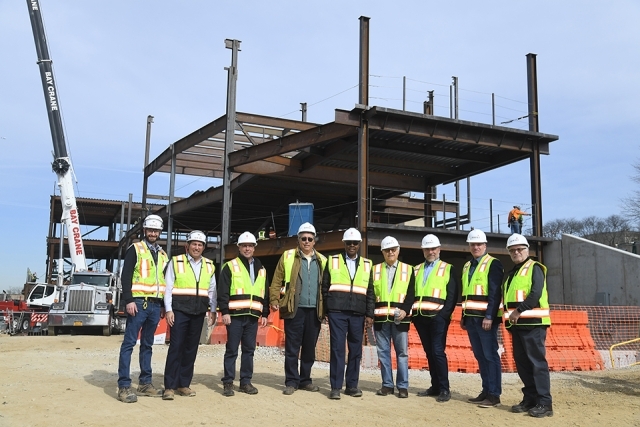Topping-Off Ceremony Marks New Construction Phase








In the 11 months since the ceremonial groundbreaking, the skeleton of the new St. Vincent Health Sciences Center has slowly and steadily taken shape and changed the landscape of the expansive Great Lawn at St. John’s University’s Queens, NY, campus.
When the final steel beam is hoisted above the construction site on Tuesday, April 25, in a ‘topping-off’ ceremony—a long-standing tradition of construction workers, particularly steel workers, to commemorate the completion of a building’s structure—a new phase of the building construction begins.
“The daily progress being made on the new Health Sciences Center is more visible and we are most excited to move to the next phase of the construction,” shared Brian Baumer, Associate Vice President of Campus Facilities and Services. “With 1,137 columns and beams and 875 tons of steel being utilized, the foundation of the building is solid—as is the future outlook of this innovative learning space.”
Scheduled to open in the Summer of 2024, the new 70,000-square-foot new home for existing and future health sciences programs ushers in a new educational era. It will be a state-of-the-art facility designed to train future generations of health-care providers and caregivers not just for today’s conditions, but for tomorrow’s unimagined needs.
“Reaching the topping off milestone on the St. Vincent Health Sciences Center is an exciting accomplishment and we’re incredibly grateful for the opportunity to collaborate with St. John's University, CannonDesign, and our many trade partners to bring this vision to life,” said Dave Margolius, executive vice president of Shawmut’s New York Metro region. “At Shawmut, we believe that our passion for building must be grounded in a deeper purpose. As we reflect on the foundation of this project, we are proud to play our part in creating a space that embodies the university’s values of compassion and service while advancing their mission to educate the next generation of caretakers, who will undoubtedly make extraordinary impacts in our communities.”
The building is designed to mediate between the iconic grouping of academic buildings to the north that ring the Great Lawn and the more loosely arranged residential village to the south. The facade visually engages the main east-west campus walk and St. Thomas More Church with two lantern-like towers. Outside, new plazas and terraces will tie directly into the campus walkway system.
The new academic building will include active learning classrooms, laboratories, simulation facilities, office space, collaborative spaces, and an outdoor terrace. It will promote interprofessional education among existing academic programs to enable students to learn together and work as a team, like the real-world situation found in any clinical setting.
A bright, sun-splashed atrium will welcome visitors to the center as they enter from the Great Lawn. The Dorethea and Nickolas Davatzes Atrium—named to memorialize Nickolas “Nick” Davatzes ’62C, ’64G, ’95HON, Trustee Emeritus, cable television pioneer, and Dorothea Hayes Davatzes ’66Ed—will feature seating areas, group study rooms, and interactive collaboration spaces on each level of the building.
The building is centered on an interior, multistory, social common space. This “living room” will act as the heart of the academic program and promote formal and informal interactions between students and faculty.
The leading-edge simulation facilities will allow students to learn in a safe, realistic, clinical environment before they begin clinical rotation assignments at off-campus sites. Flexible room layouts will accommodate a multitude of teaching and learning styles. Structural and mechanical systems will allow for reprogramming of the spaces within the building.
Design plans for the center will make it very energy efficient. The building will make a positive contribution to the St. John’s Climate Action Plan and will also utilize biophilic design (i.e., direct and indirect connections to nature) material choices, and social spaces to provide a healthy and engaging place to study and work.
The building will be heated and cooled using a geothermal field, which will include up to 66 wells drilled 499 feet below ground. “If we dug any deeper than 499 feet, that would have required a mining license,” stated Mr. Baumer.
Geothermal energy is a renewable energy source that comes from reservoirs of hot water beneath the Earth’s surface. With innovative applications in several economics sectors—electricity, industry, and buildings—increased use of geothermal energy serves to decrease the use of fossil fuels and the resulting greenhouse gas emissions.
State-of-the-art technology will control lighting, space occupancy, and temperature throughout the building. An array of solar panels on the roof will further help reduce the energy consumption of the building, helping to make it one of the greenest on campus. High-performance, energy-efficient windows will reduce thermal loss. The elongated east-west floor plan of the building will maximize daylight and skylights will help reduce lighting usage by 22 percent during daylight hours. The building is designed to obtain a Leadership in Energy and Environmental Design (LEED) Silver certification.
While a few long-existing trees on the Great Lawn were removed as part of the construction project, for every tree removed, two new ones will be planted. The new trees will be enhanced by outdoor gardens that will literally nurture and sustain a Vincentian ministry of compassionate care that preserves the human dignity of persons in need of healing within a diverse and changing society.
Related News
Alumna Celebrates Book Launch After Career Change
After developing a passion for helping the younger generation, Ashley Wilson ’14M.S.Ed. pivoted from a career in the music industry to work as an educator. She is also making her mark through her new...
Dean Jerrold Ross Conference Room Unveiled
On Tuesday, December 10, the newly renovated conference room on the fifth floor of Sullivan Hall was dedicated in honor of Jerrold Ross, Ph.D., former Dean of The School of Education . The renovation...
Institute for Catholic Schools Provides Educational Resources to Local Catholic School
The Institute for Catholic Schools (ICS) in The School of Education at St. John’s University recently donated approximately $2,800 worth of academic and sensory learning tools to Father Vincent...
